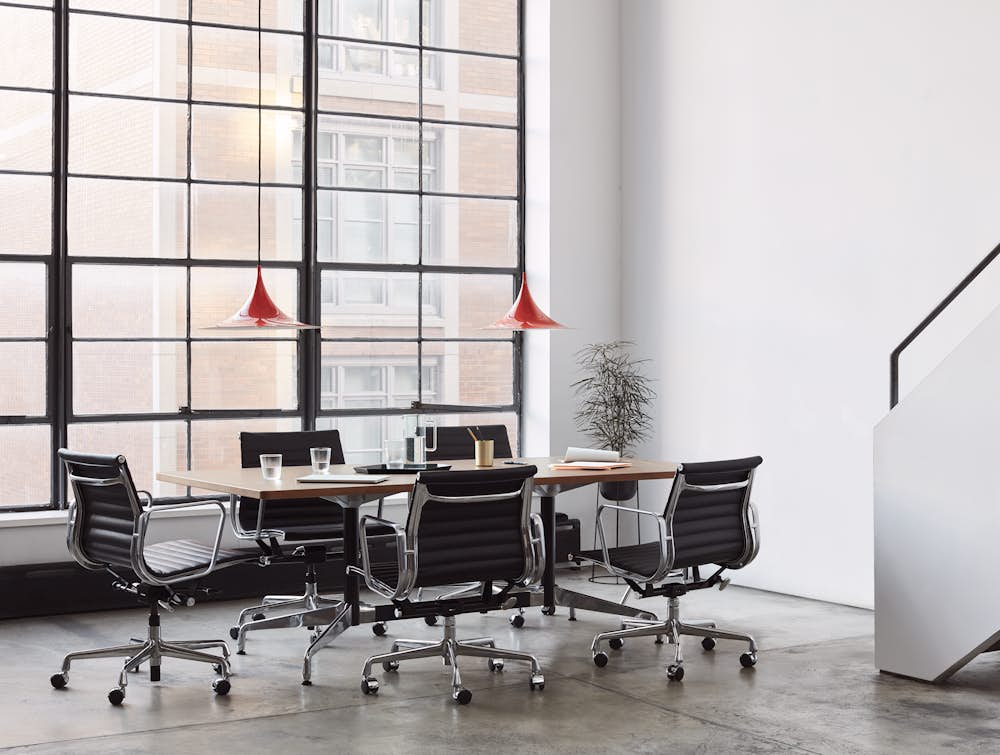It’s estimated that more than 60 percent of the U.S. workforce worked from home at least three days a week during the height of the COVID-19 pandemic [1]. While remote work flexibility was already gaining momentum as a way for employers to incentivize employees, the effects of the pandemic greatly accelerated this trend. As of 2022, the proportion of the U.S. workforce working remotely at least weekly was stable at 35-40 percent.
Business spaces have been transforming with this transition to hybrid work. Workflows are also changing, as employees rotate in and out of desks, while some remain at home full-time. Naturally, office managers have been forced to re-evaluate the needs of the physical office space, which is becoming more dynamic than ever.
The Flexibility of Hybrid Work
In the hybrid work model, employees divide their time between the office and the home/somewhere else. This can look different across many types of businesses. At one company, employees might work two or three days remotely every week, with the other time devoted to in-person office work.
At another business, hybrid work could vary from employee to employee, and even from day to day. For example, one employee might come into the office for an in-person brainstorming session with their colleagues or clients but then decide to work from home during a solo project or more focused work that benefits from fewer distractions. Another employee at the same company might opt to work remotely every Wednesday.
Hybrid work offers a number of benefits, including:
- Enhanced productivity
- Increased efficiency
- Better work-life-balance
- Improved inclusivity and equity
- Lower absenteeism rates
- Reduced carbon footprint
- Lower facility costs (for those businesses that decide to downsize their office spaces)
Sources: [2, 1]
To make the most of the hybrid approach, you must be willing to experiment and adapt as you find the best style of work for your business. Having adaptable, flexible furniture can ease this transition, as you repurpose and reconfigure to meet the changing needs of your workforce.
Encouraging Collaboration and Camaraderie
While working from home can be great for employees, it can also sometimes feel isolating and restrictive. Homes with small children or other remote workers can create additional challenges. For this reason, there is a growing need to create spaces that foster co-working and socializing. To facilitate this, businesses need to invest in furniture solutions that focus on adaptability and agility.
The new office should center on flexibility. Rather than being focused on single-purpose furnishings that are prescriptive and stationary, the new office should empower workers to repurpose, regroup, and reconfigure spaces on the fly. A multifunctional office requires furniture that is more modular, component-based, and can be mixed and matched as needed.
For example, if your business requires a high level of collaboration, a mobile easel or whiteboard could help nurture a more flexible environment. These furnishings easily convert distinct workstations into unified, temporary co-working spaces. They also keep ideas in motion for impromptu brainstorming sessions, so people don’t need to stop and book a conference room every time they want to collaborate.
At Herman Miller, we developed our OE1 Collection of optimized, essential office furniture specifically for this new workplace paradigm. The mobile desks, storage, and more are designed to help business owners and employees experiment with space, discover what works in the moment, and evolve.
Evolving from “Owned” to “Shared” Spaces
The traditional office model generally assigns one desk to one person and separates these workspaces with walls or partitions. But with a sizeable portion of the workforce working remotely at any given time, this approach can lead to empty chairs and wasted space.
As a business owner, you can adopt a few techniques to facilitate collaboration and make more efficient use of your resources. For instance, try moving to a neighborhood seating model. This approach involves clustering groups of individuals in the workplace so that those with shared needs and work goals sit together. The neighborhood seating model can help deepen relationships and encourage increased communication between employees.
With thoughtfully designed communities, collaboration happens organically. Employees are encouraged to sit with frequent collaborators whenever they come into the office, or for the duration of a project. They are also free to explore different office neighborhoods and work alongside other co-workers.
Modular and adaptable furniture can help facilitate these shared collaborative spaces because it can be easily configured and reconfigured as needs change.
Maximizing Limited Space
Another reality of the COVID-adapted workplace is that many businesses are having to do more with less space. During the pandemic, 68 percent of CEOs said they were planning to downsize their office space [3]. Adaptable furniture can help create a workplace that fits more into less while still making the workplace as comfortable as possible. Multifunctional, reconfigurable furniture allows your office kitchen, for example, to easily become an informal meeting space.
If, like other business owners, you find yourself trying to do more with less, furniture that is lightweight, mobile, and adjustable can help you accommodate the changing needs of your workforce.
Finding the Best Furniture for Your Best Work
From rows of cubicles to open-concept office plans, the needs of the modern office are always in flux. With the widespread embrace of hybrid work, businesses need to thoughtfully consider the types of furnishings that will enable their employees to do their best work––whether they’re at home, across the world, or in the office.
The companies that will thrive in our new reality are the ones that demonstrate flexibility and adaptability and are attuned to the needs of their unique workforce. To meet this demand, Herman Miller has dedicated itself to creating furniture solutions that enable collaboration, camaraderie, and inspiration.
Citations
- https://globalworkplaceanalytics.com/work-at-home-after-covid-19-our-forecast
- https://www.gallup.com/workplace/283985/working-remotely-effective-gallup-research-says-yes.aspx
- https://www.millionacres.com/real-estate-investing/articles/68-of-large-companies-plan-to-downsize-office-space-what-it-means-for-investors/

